As you may have heard, the Asian Long-horned Beetle (Anoplophora glabripennis) was recently discovered for the first time in South Carolina. The species is a native to Southeast Asia. It first appeared in the United States in 1996 in Brooklyn, New York followed by Illinois in 1998, New Jersey in 2002, Massachusetts in 2008, and Ohio in 2011. In June of 2020 it was discovered in Hollywood, SC. Biologists suspect the infestation has been ongoing for five or more years. So far, more than 2,000 trees have been confirmed to be affected in Ravenel, Hollywood, Meggett, and Johns Island. The infestation appears to be centered on Rantowles and Stono Ferry, encompassing more than a 3-mile radius.
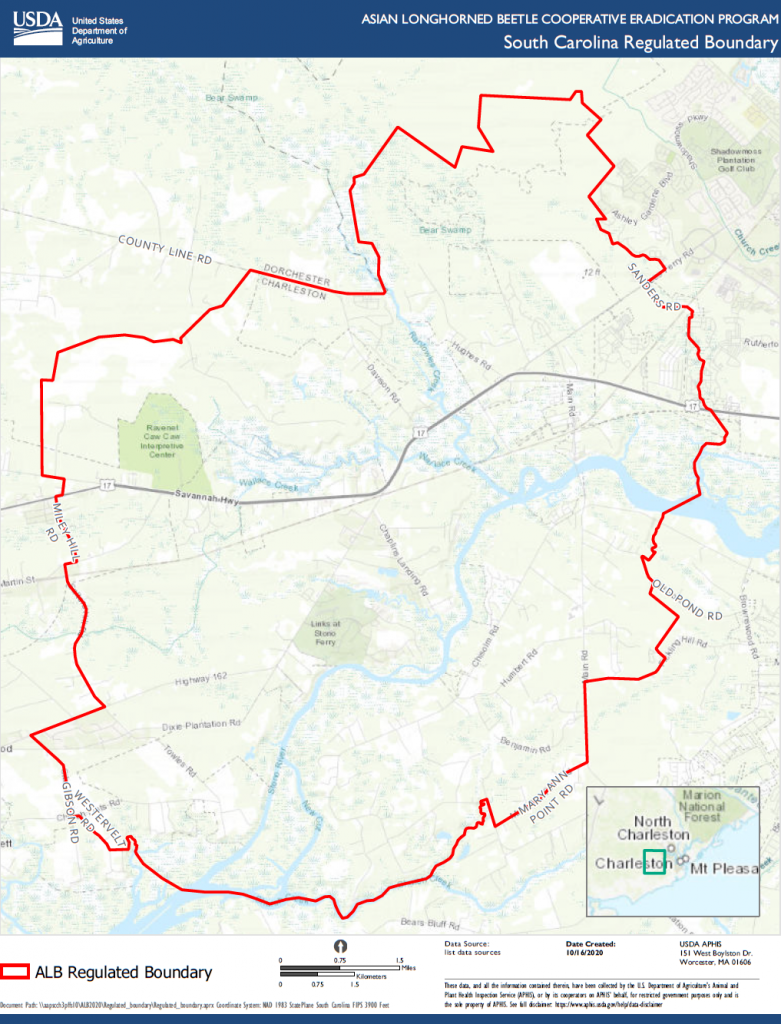
The Asian Long-horned Beetle is an invasive species of insect. Its larvae feed on the wood of native trees, leading to the structural collapse and eventual death of those trees. As a non-native exotic, the beetle has few natural controls and the trees lack sufficient defenses to fight the beetles. This can result in the beetles spreading unchecked through the ecosystem, destroying forests and altering habitats permanently. This potential for uncontrolled growth and ecological damage is what defines the species as an invasive and what makes its discovery so alarming.
The primary larval host plant for Asian Long-horned Beetles here in the Lowcountry is by far Red Maple (Acer rubrum). Red Maple is a native tree that is extremely common in our forested wetlands, bottomlands, and river floodplains. Red Maple is also used extensively in suburban landscaping. The beetle will feed on other tree species as well including Ash, Willow, Elm, Birch, Cottonwood, Sycamore, and possibly Tupelo. They are not known to infect Oaks or Conifers, including Pine. Biologists fear that the beetles will escape into the remote bottomland and floodplain forests surrounding Ravenel. Here they will be much more difficult to control and they may make the jump into infesting Tupelos. The uncontrolled destruction of the Maples and Tupelos of our bottomland forests would be devastating for one of the most critical ecosystems here in the coastal plain of South Carolina.
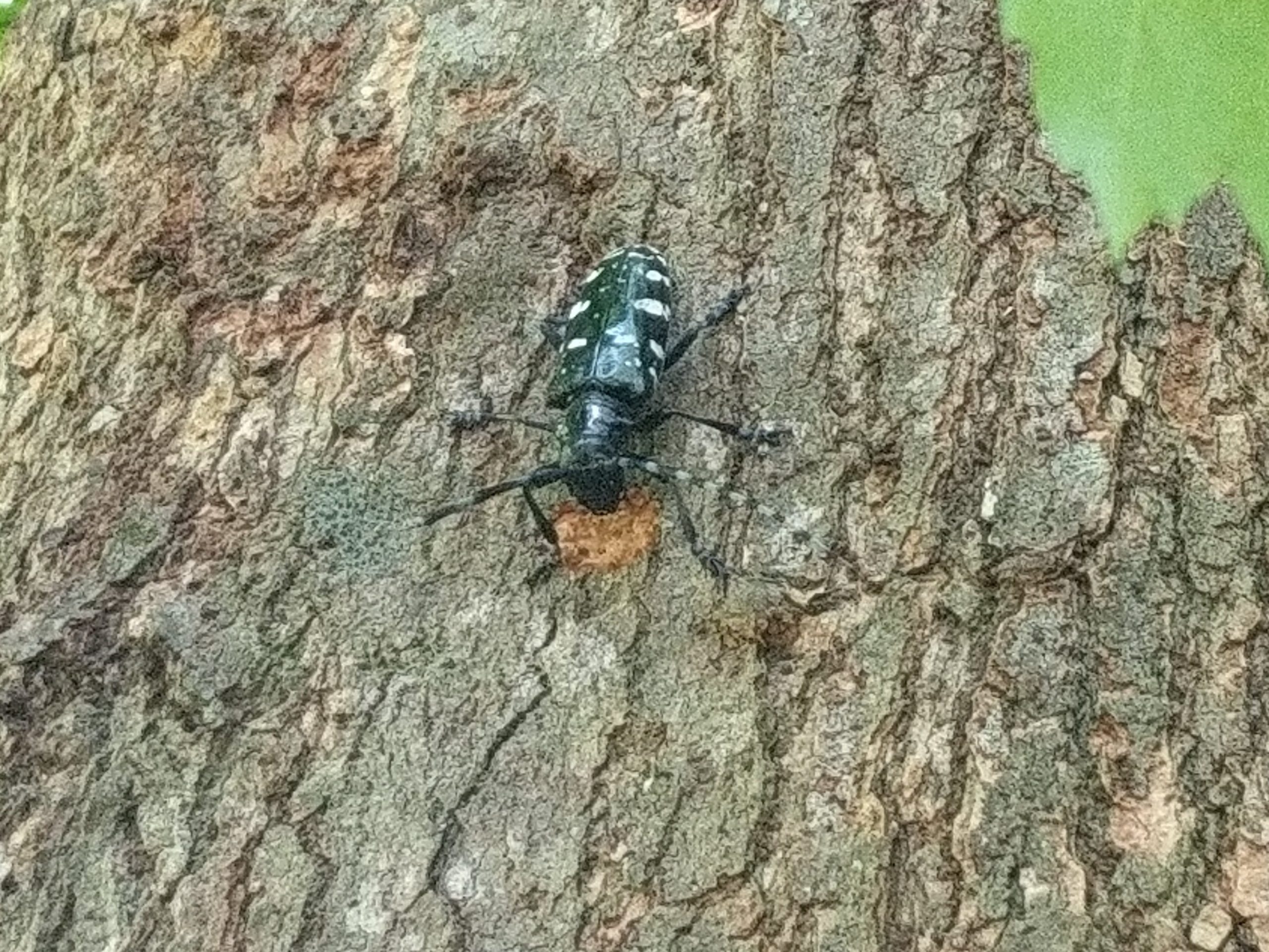
The adult beetles are metallic blue-black, covered with white spots, and an inch or more in body length. They are quite large and have black and white banded antennae longer than their body. Female beetles leave behind distinct marks on the bark of trees when laying their eggs. Females chew a shallow 3/4 inch scar in the tree’s bark, nicknamed a “cigar burn”, and lay an egg inside. The newly hatched larvae first feed near the surface of the trunk before moving into the heart of the tree. Wood of infected trees can be identified by the finger-width tunnels the larvae leave behind inside the wood. Adults emerge in summer, leaving a deep and perfectly circular half-inch hole in the side of the trunk.
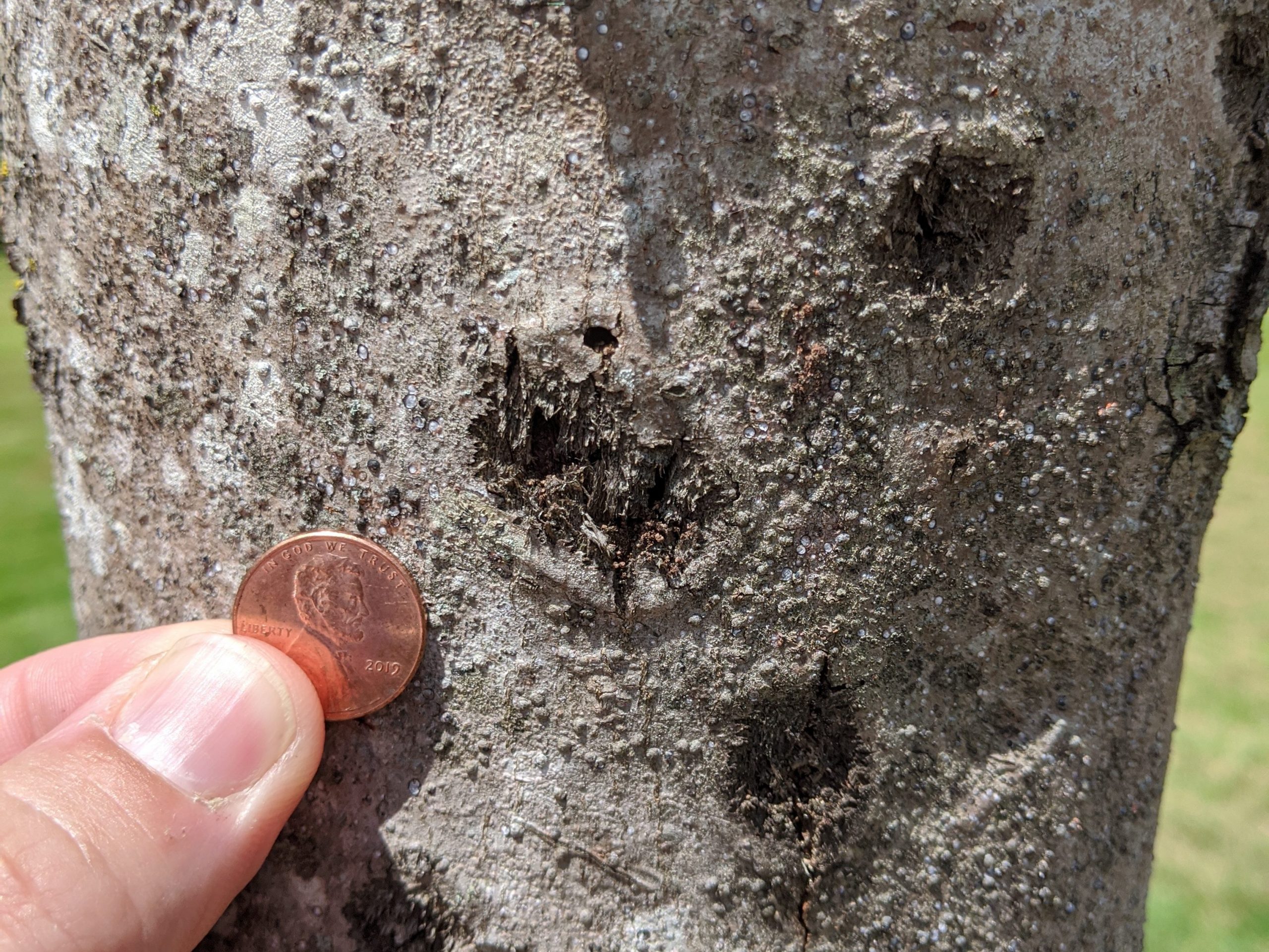
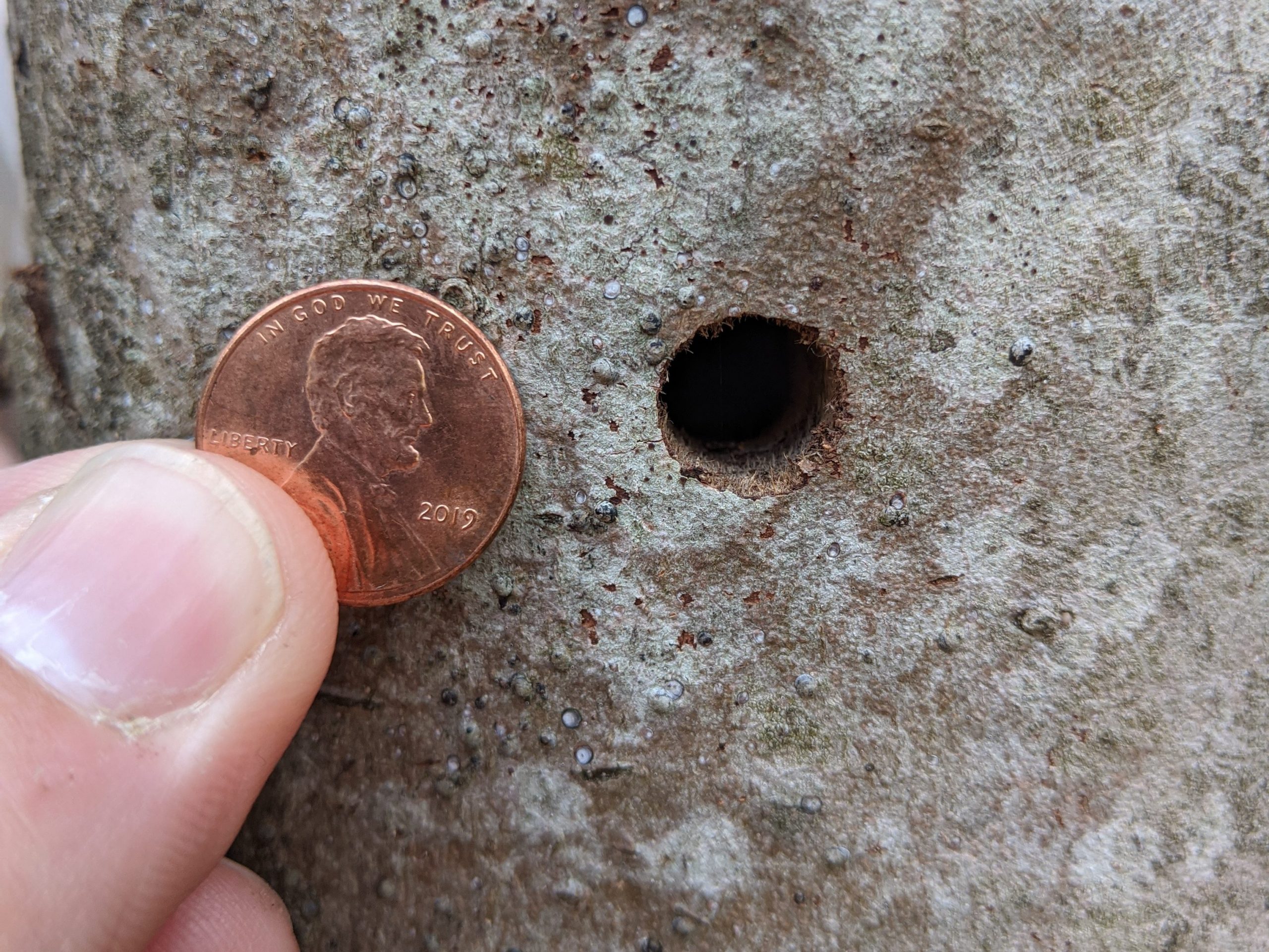
However, all is not lost! The USDA, Clemson University, College of Charleston, and the SC Department of Natural Resources are making a serious and concerted effort to eradicate this dangerously invasive beetle from the South Carolina Lowcountry for good. The College of Charleston’s Stono Preserve was one of the first confirmed sights of Asian Long-horned Beetle in the state and they are working to facilitate the USDA’s establishment of a quarantine headquarters on the property. The USDA and Clemson University are jointly working to assess the scope of the infection and are drafting quarantine protocols and regulations for the area. SCDNR is proactively surveying all Red Maples on their 690-acre Dungannon Heritage Preserve, which is located in the heart of the infestation. The USDA was previously successful in eradicating the Asian Long-horned Beetle from New Jersey, Illinois, and much of New York and Massachusetts. There is still a good chance we can nip this problem in the bud before it gets out of control, especially with your help.
You too can help control the spread of the Asian Long-horned Beetle. Together we can stop it from ravaging our native ecosystems! First and foremost, if you see an adult beetle or the distinct marks they leave behind on host trees, report it to the USDA’s APHIS or Clemson Extension immediately! (Contact info below.) They’re the experts on handling this pest and they’ll know what to do. Other than that, the best thing you can do is not transport firewood or woody yard debris out of or within the infected area. Asian Long-horned Beetle larvae may be living inside of the wood and, if brought out of the quarantine area, can emerge to infect new areas of our state. The adult beetles only emerge during summer, do not live very long, and don’t move very far during that time. By not transporting wood within the infested area, we can drastically reduce the chances of live beetles escaping quarantine and destroying habitat in the surrounding coastal communities, such as Edisto Island.
Further reading on the Asian Long-horned Beetle:
USDA: THE LATEST NEWS ON THE ASIAN LONG-HORNED BEETLE
CLEMSON: MORE INFORMATION ON THE BEETLES IN SOUTH CAROLINA
Where to Report Asian Long-horned Beetle sightings:
Call the USDA at: (866) 702-9938
Contact Clemson: (864) 646-2140 or invasives@clemson.edu
Article by: Tom Austin, Land Protection Specialist for EIOLT
Photos by: Steven Long, Clemson University, Dept. of Plant Industry
Greetings from the EIOLT Education Outreach Committee! We have another learning opportunity for your presented by one of our local experts in the field.
In our third episode of Conversations in the Field, Melinda Hare is joined by local biologist and EIOLT’s very own Land Protection Specialist, Tom Austin. Tom explains the importance of grassland ecosystems to agriculture and the environment here on Edisto Island and in the surrounding Lowcountry. Tom also shines a light on what EIOLT is doing to conserve the gorgeous wildflower meadows at the Hutchinson House.
We hope you enjoy this informative presentation on a topic seldom covered.
Greetings from the EIOLT Education Outreach Committee! It’s time for another learning opportunity with one of our local experts in the field. In our second edition of Conversations in the Field, join EIOLT Board member and Master Naturalist, Lindsey Young, as she takes us on a special kayak trip through Big Bay Creek and the surrounding creeks on Edisto. This is your chance to learn about the variety of shorebirds that are often seen around our waterways as well as one of our local favorites – the Atlantic bottlenose dolphin.
If you’ve been stuck inside and want to experience the zen of a peaceful paddle on the water, this conversation about creek life is for you!
Greetings from the EIOLT Education Outreach Committee! We have been busy creating some new online learning opportunities just for you. This is the launch of our series, “Conversations In The Field”. We will be bringing you experts in a variety of fields who will discuss environmental and conservation topics.
Our first episode features Harleston Towles, a local farmer here on Edisto Island. Many of you requested this field trip, which we have had to postpone due to COVID-19. So instead we are taking you virtually to the field to see his farming operation and the beginnings of your Twenty Bag! Harleston incorporates sustainable and organic farming practices into his farm, Rooting Down Farms. These practices allow him to grow delicious, fresh local vegetables without harming the local environment, over-taxing the soil, or sacrificing the quality of the produce.
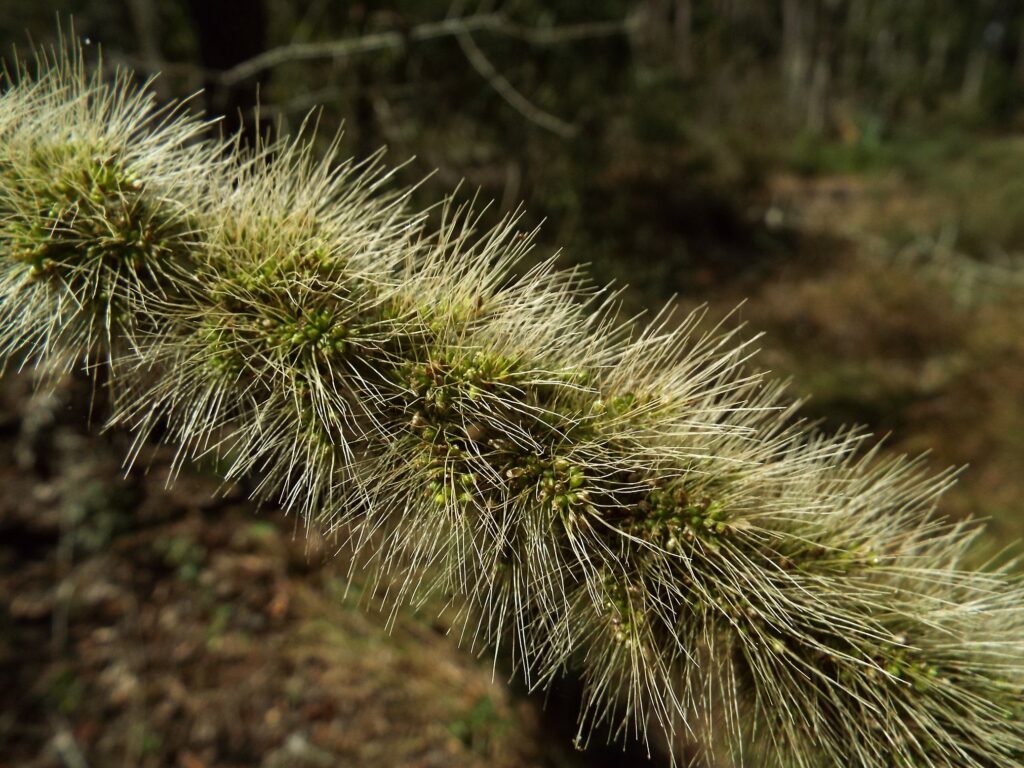
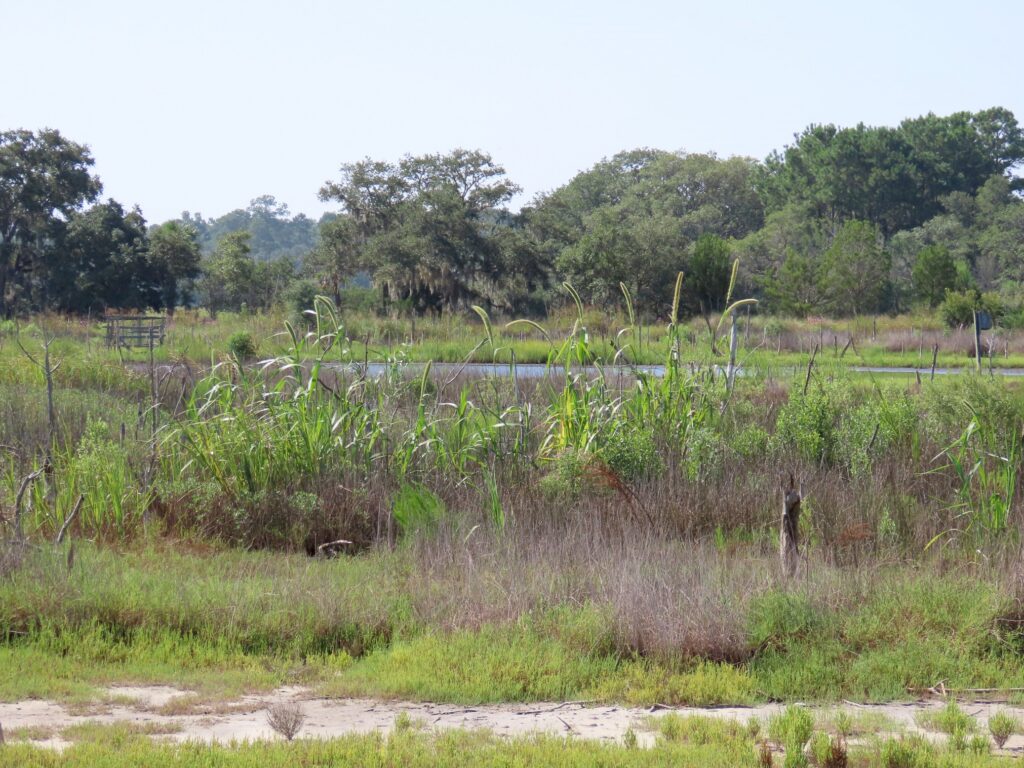
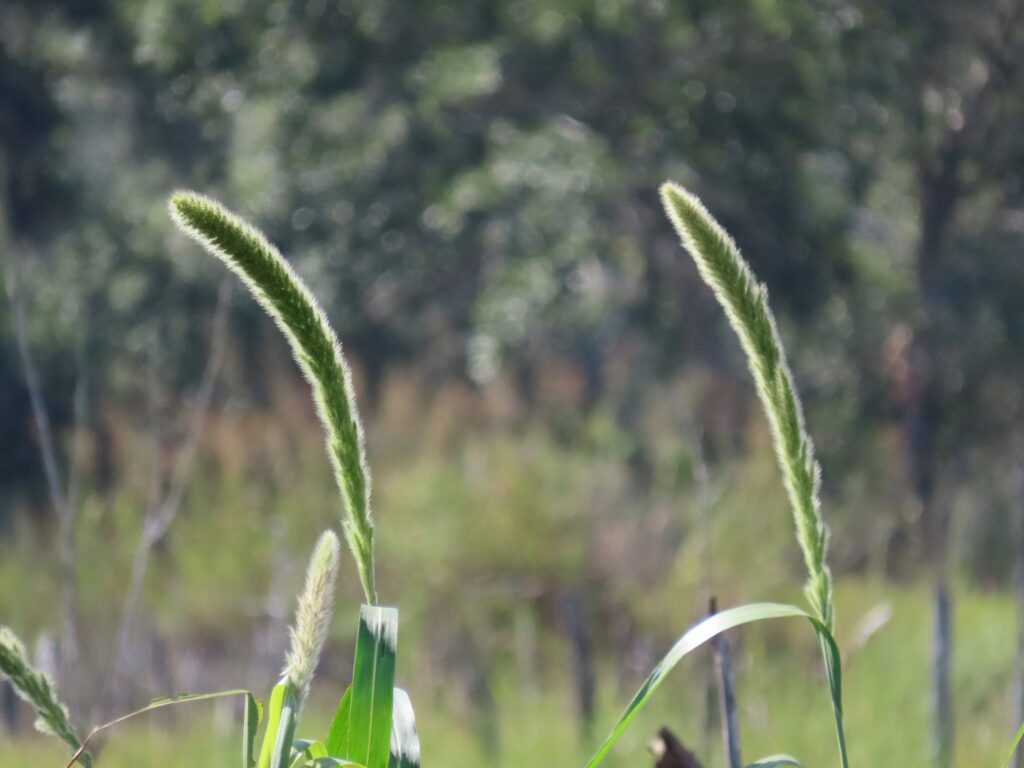
This week for Flora and Fauna Friday, we have an overgrown bushy-tailed grain-like wetland grass: Giant Bristlegrass (Setaria magna).
Giant Bristlegrass is a member of the Bristlegrass genus, Setaria. Bristlegrasses all share a similar growth habit: stiff flower stalks with widely spaced leaves that end in a bristly cylindrical cluster of seeds. The most famous of the genus, Foxtail Millet (Setaria italica) was domesticated more than 10,000 years ago and is still grown widely as a food grain throughout Asia. Here in the Lowcountry, we have three native species of Bristlegrass (Giant, Coastal, and Marsh) and two invasive species (Green and Yellow). Of those, four are relatively small and fairly innocuous grasses that, to the untrained eye, can easily be mistaken for one another. However the fifth, Giant Bristlegrass, stands out above the rest, literally.
Giant Bristlegrass can easily exceed six feet in height with a seed head a foot long and an inch and a half in diameter. Individual plants grow as clumps and often have a half-dozen or more seed heads at once. When several plants grow together, they can really standout above a marsh or wetland. They grow in brackish marshes in saturated soils and tolerate periodic salt intrusion well. Seed heads mature in late summer and fall. The seeds of Giant Bristlegrass provide food for resident rodents and songbirds and migrating sparrows during winter.
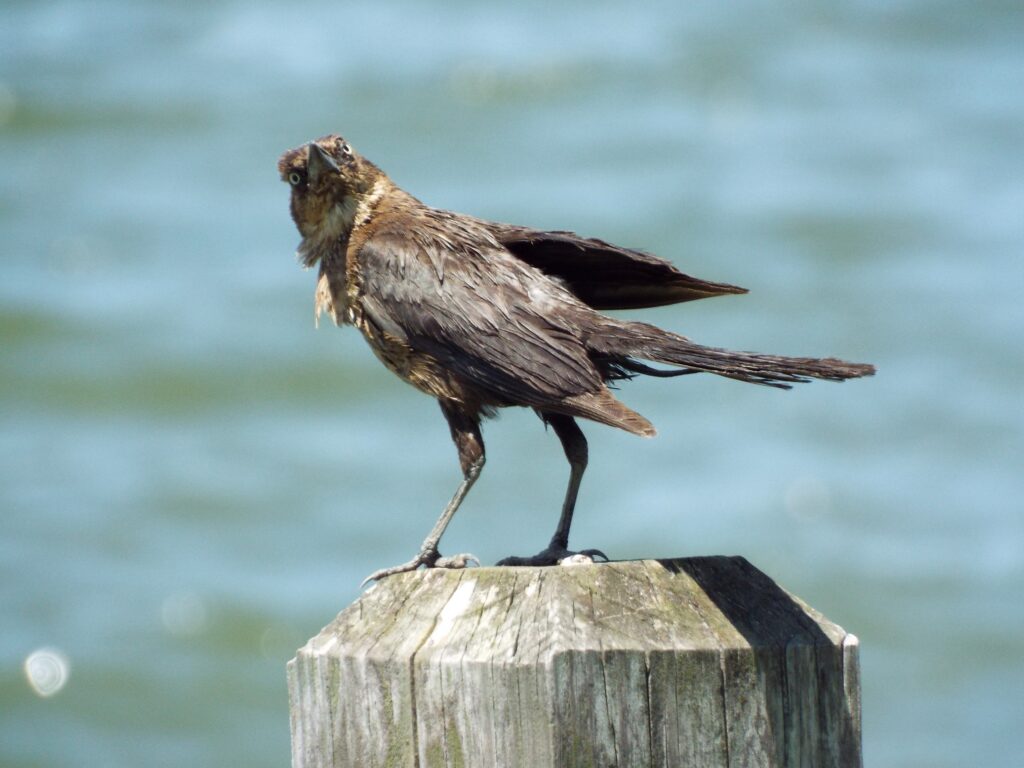
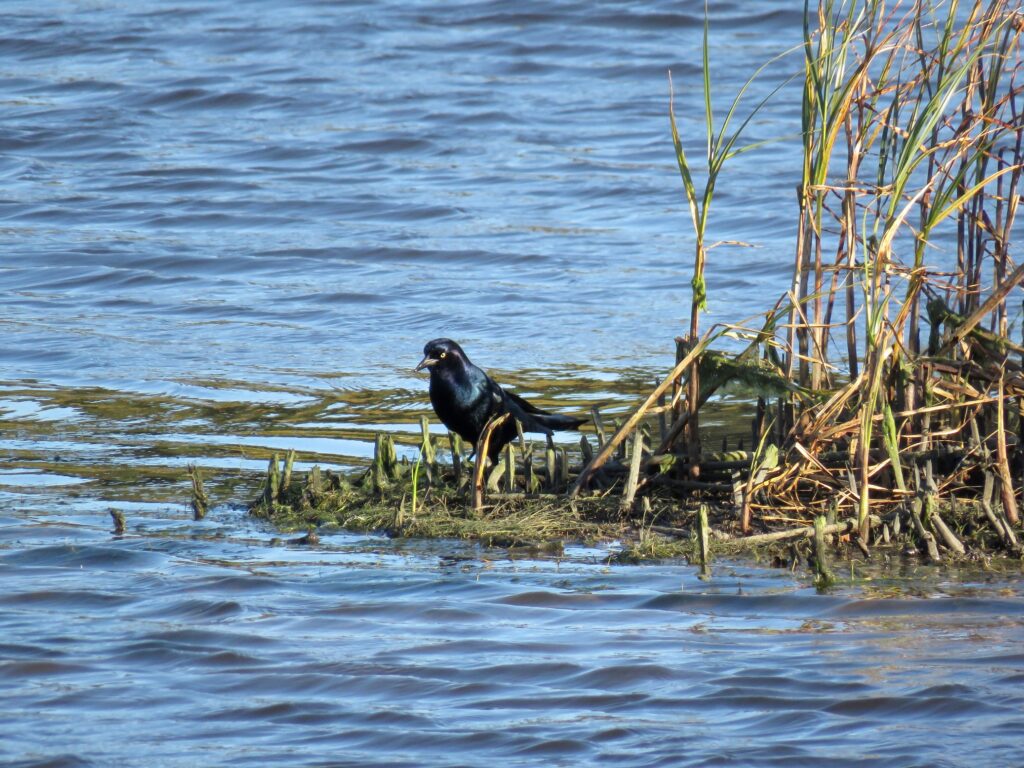
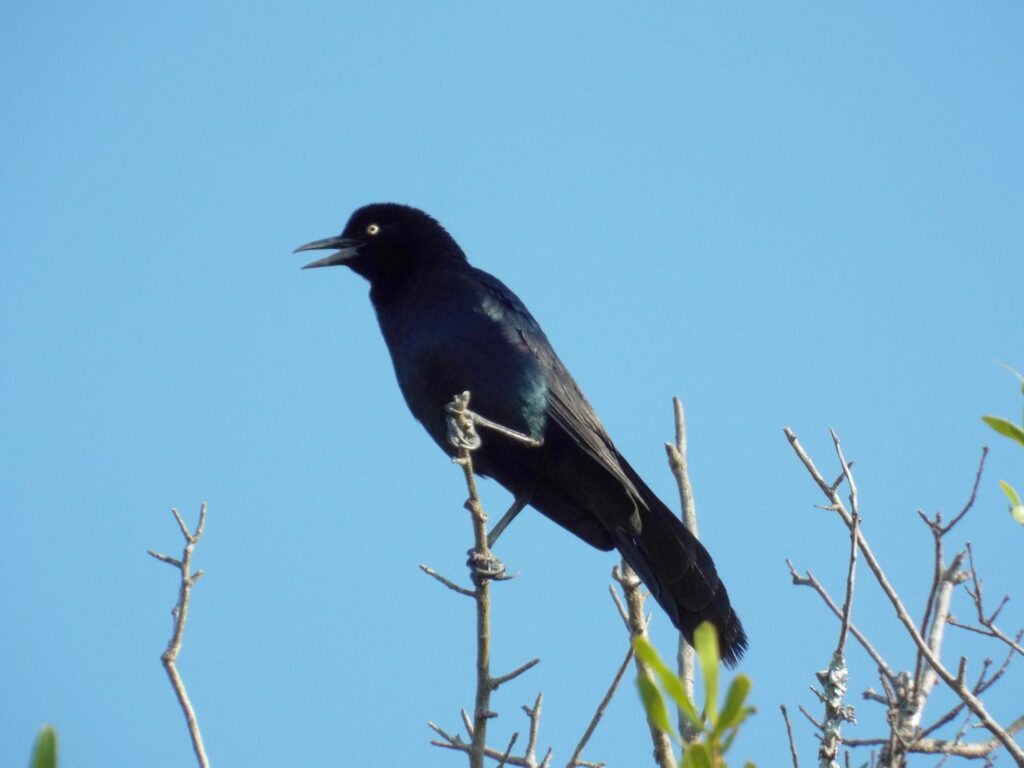
This week for Flora and Fauna Friday, we’re hearing the inane and insane babbling of the Boat-tailed Grackle (Quiscalus major).
The Boat-tailed Grackle is a large member of the Blackbird family, Icteridae, and is typically a foot or more in length. They bear a long and rounded tail, lanky legs, and a dagger-like bill. Males are an oily iridescent black that often runs into shades of indigo across the body. Females range from a washed-out walnut to cinnamon-chocolate plumage, either extreme contrasting their shale-black flight feathers. Both sexes wear a sour demeanor. A look of simmering aggravation communicated through piercing banana-yellow eyes.
The size and color of a Boat-tailed Grackle are usually more than sufficient to identify them at a glance. Yet they are even more easily identified by their voice. The song of the male is a lovely string of screeching hollers, garbled gargling, and ear-splitting buzzes that command attention but scarcely admiration. To make matters worse, they are non-migratory and live in colonies. So rarely is one treated to a single seasonal shrieking soliloquy rather than an unceasing quarrelsome quartet. Females are thankfully far less vocal, sticking to simple barks and squawks.
As mentioned previously, Boat-tailed Grackles live in sedentary colonies making them a year-round resident of Edisto Island. They are a coastal species that is highly dependent on salt marsh and other tidal wetlands for habitat. They’re often spotted roosting on hammocks, docks, and marsh grass or foraging on beaches, mud flats, and oyster beds. However, this here Grackle is quite adaptable and they’ve taken quite the shine to beach urbanization. Boat-tailed Grackles are omnivorous and they’ve found themselves at home with coastal commercialization. Much like our Laughing Gulls, they’ve taken to patrolling parking lots and wharfs in search of wayward scraps. Their colonies make good use of docks, bridges, and causeways as stages for their unintelligible ramblings and vantages for foraging. They nest low in wet thickets and over marshes, areas rarely disturbed and often nearby to coastal developments.
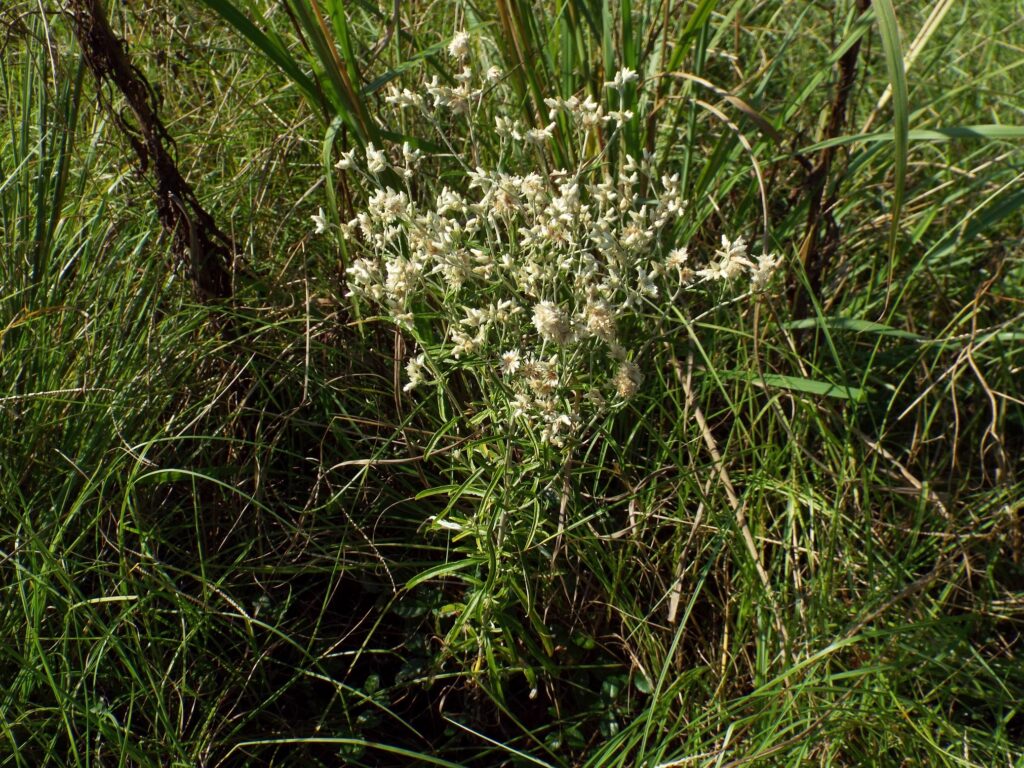
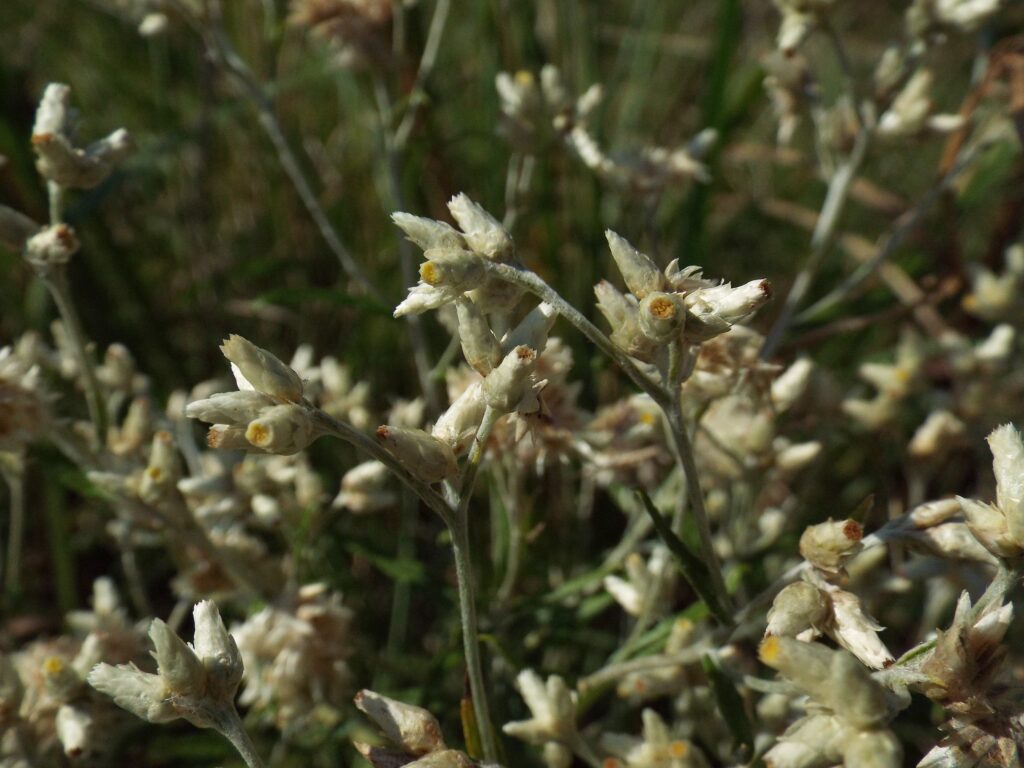
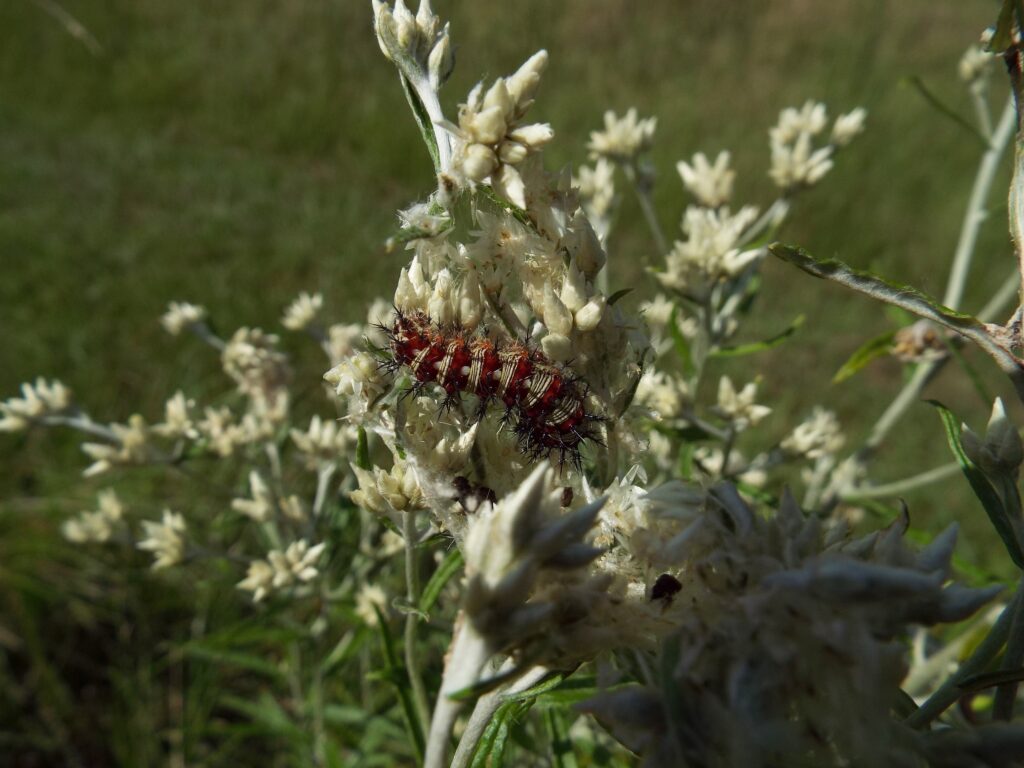
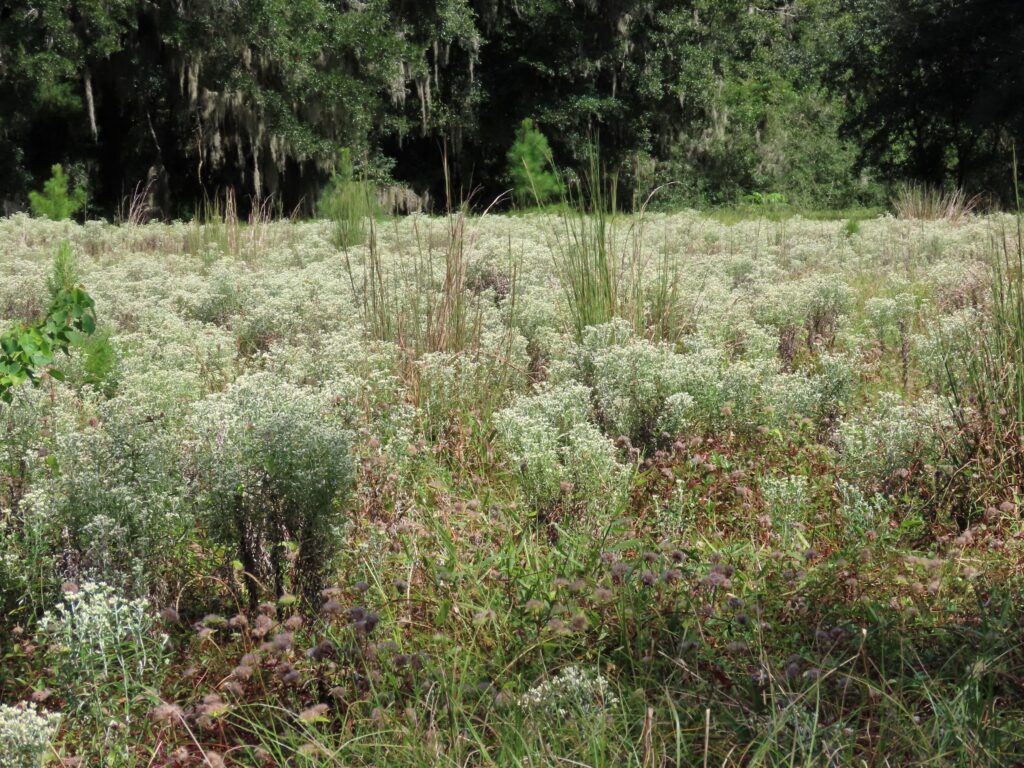
This week for Flora and Fauna Friday we have an inhalable aromatic herb that’s a host for butterflies, Rabbit Tobacco (Pseudognaphalium obtusifolium).
Rabbit Tobacco is a member of the Aster family. It’s found throughout South Carolina and the Eastern United States. It grows in open habitats on a wide array of soils but prefers dirt on the drier, sandier side in fallow hayfields. Rabbit Tobacco is an annual herb but interestingly it overwinters as a seedling to bloom and die in fall. It grows to about knee high on straight stems with foliage that gradually expands in breadth. The foliage of Rabbit Tobacco is lime-green and leathery above but upholstered below in a shimmering down of frosty silk that extends to its limbs and stem. The flowers of Rabbit Tobacco are small, white, and egg-shaped with an almost glowing golden opening at the tip. The flowers themselves are actually assemblages of many tiny flowers packed together. These packages of flowers are grown in clusters of a half dozen or so. Each of these clusters is again grouped into a half-dozen or so at the tip of each stem, and all of those groups are compounded into a collection of every stem and stalk that build into a cloud of flowers. This pale and puffy appearance makes Rabbit Tobacco stand out clearly from your average wildflower, floating like a foam atop the sea of undulating hay submersing a fallow field. The flowers of Rabbit Tobacco provide both nectar and pollen to our smaller native pollinators. They also smell like maple syrup! The scent of pancakes wafting in the breeze is unmistakable where these wildflowers thickly bloom. The flowers eventually mature into a cottony glob of tiny windblown seeds.
Rabbit Tobacco is the host plant for the American Lady butterfly (Vanessa virginiensis). The Lady’s caterpillars feed on the plant by weaving leaves and flowers into a protective shield around itself. These spiky red and white caterpillars can often be found nestled amongst the flowers of Rabbit Tobacco, munching away in their cozy cage.
As the common name alludes, Rabbit Tobacco is also an herb that has historically been smoked or burned as incense by both Native Americans and colonists. The plant indeed has quite a pleasant aroma when fresh, crush, or burned. Yet, the plant has no significant concentration of neurochemicals. It is smoked primarily for the flavor and scent as well as a myriad of purported health benefits. However, there has been no scientific documentation to corroborate any of the plant’s claimed medicinal properties. Most empirical evidence points to it being more harmful than helpful.
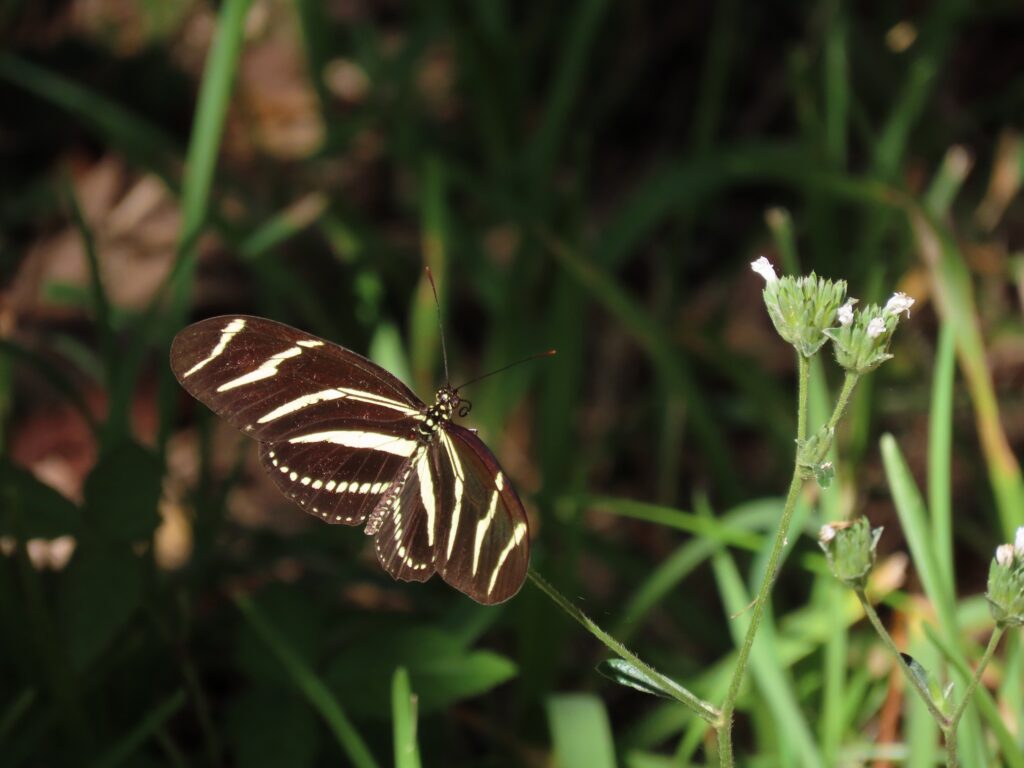
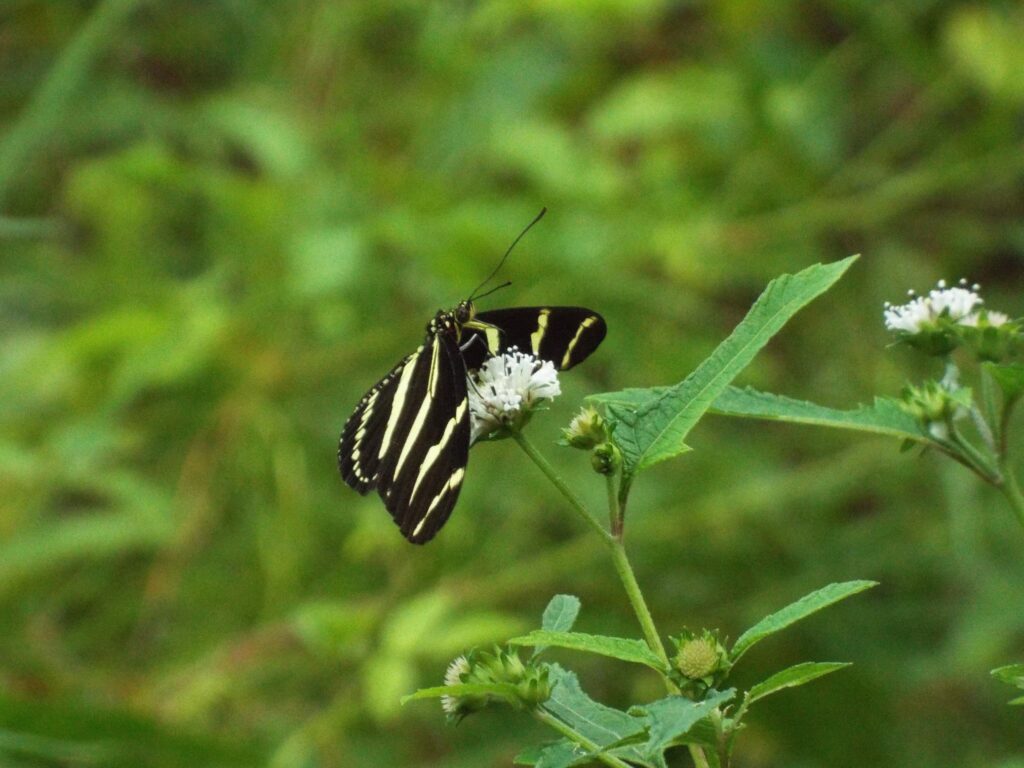
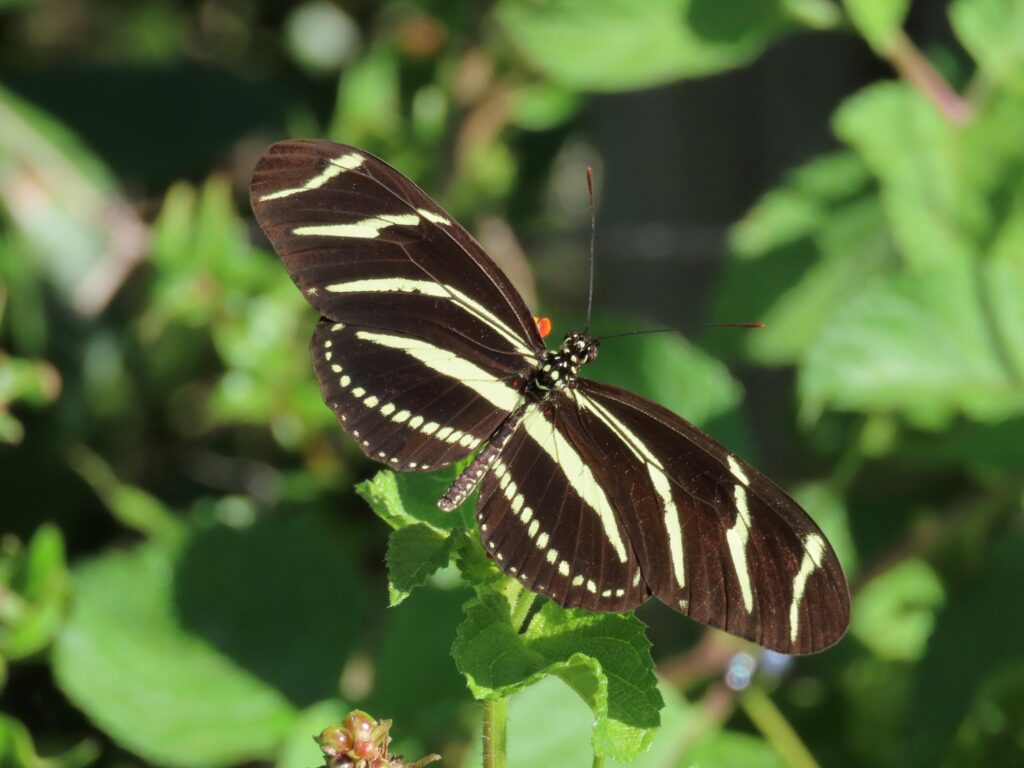
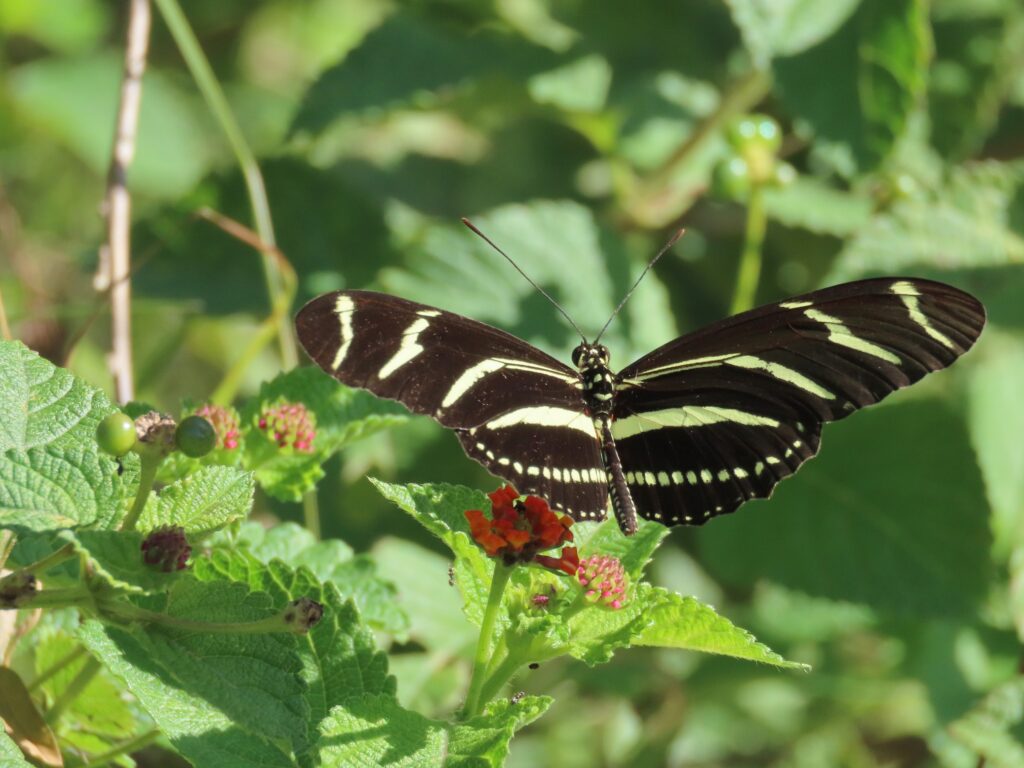
This week for Flora and Fauna Friday, we have a tottering tropical butterfly that vacations on our Island every fall: the Zebra Longwing (Heliconius charithonia).
The Zebra Longwing, or Zebra Heliconian, is a member of the Brushfoot family of butterflies, Nymphalidae. Practically speaking, it’s our only Heliconian in the States but has a close relation to the Gulf Fritillary (Agraulis vanillae). Zebra Longwings are one of those species with an eloquently accurate common name. One where simply remembering that name is sufficient to ID the species. To elucidate, Zebra Longwings have long wings with a zebra pattern on them. A granular matte-black back split seemingly six ways by a quartet of diagonal pastel-yellow stripes and a southward staccato string of spots that is echoed bi-laterally across its body and down its hindwing’s fringes. The down below of this two-tone show is highlighted by a sprinkling of carmine blotches along the flanks of our butterfly.
The Zebra Longwing is graceful and delicate in appearance, slowly fluttering in aimless ballet between the sun flecks of a shade tree. Departing, approaching, circling, wandering and returning through this haunt of its choosing. Rarely fleeing but scarcely approachable. Zebra Longwings are partial to shady, calm forest edges with little wind and dense vegetation. They patrol a territory of nectar plants throughout the day. Visiting the same flowers day after day from dawn to dusk. Zebra Longwings host on Passionflowers. Here in South Carolina, they specifically lay eggs on Yellow Passionflower (Passiflora lutea) which is partial to much the same habitat as our butterfly. Their caterpillar is as unmistakable and boldly patterned as its parents, with a porcelain white skin spotted and spined by glistening black. Zebra Longwings, as mentioned before, are a tropical species. They rarely persist in our State for more than a season and some years they hardly make their way to South Carolina. Yet, in other years they can weather a mild winter here on Edisto and appear the following spring.
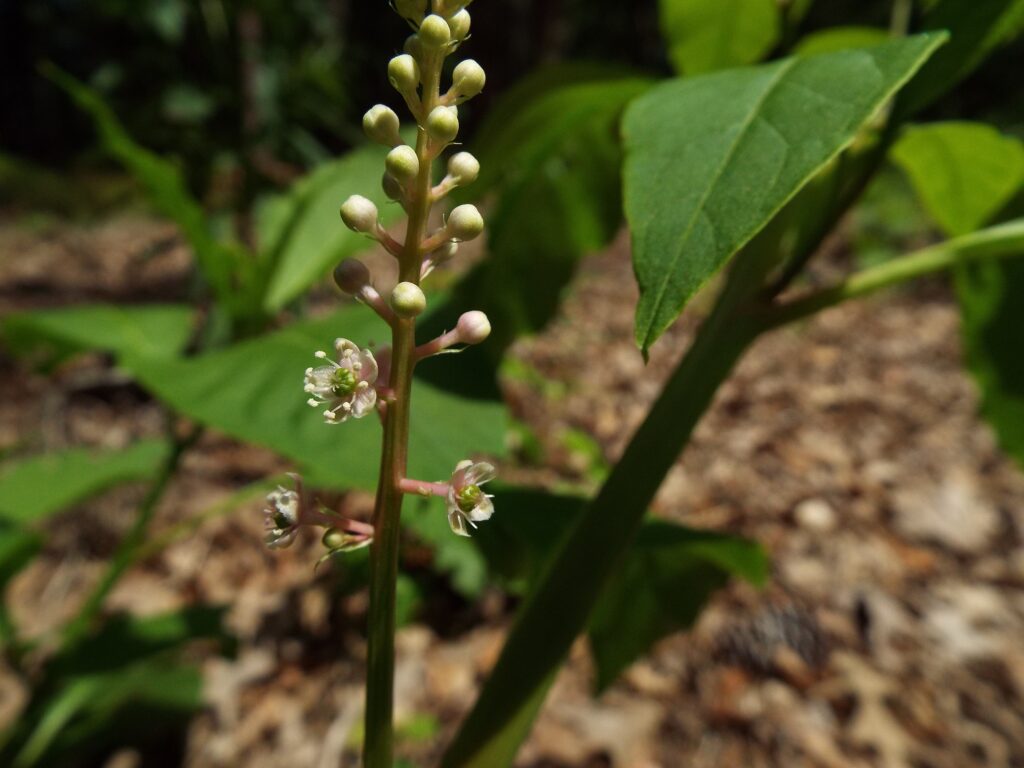
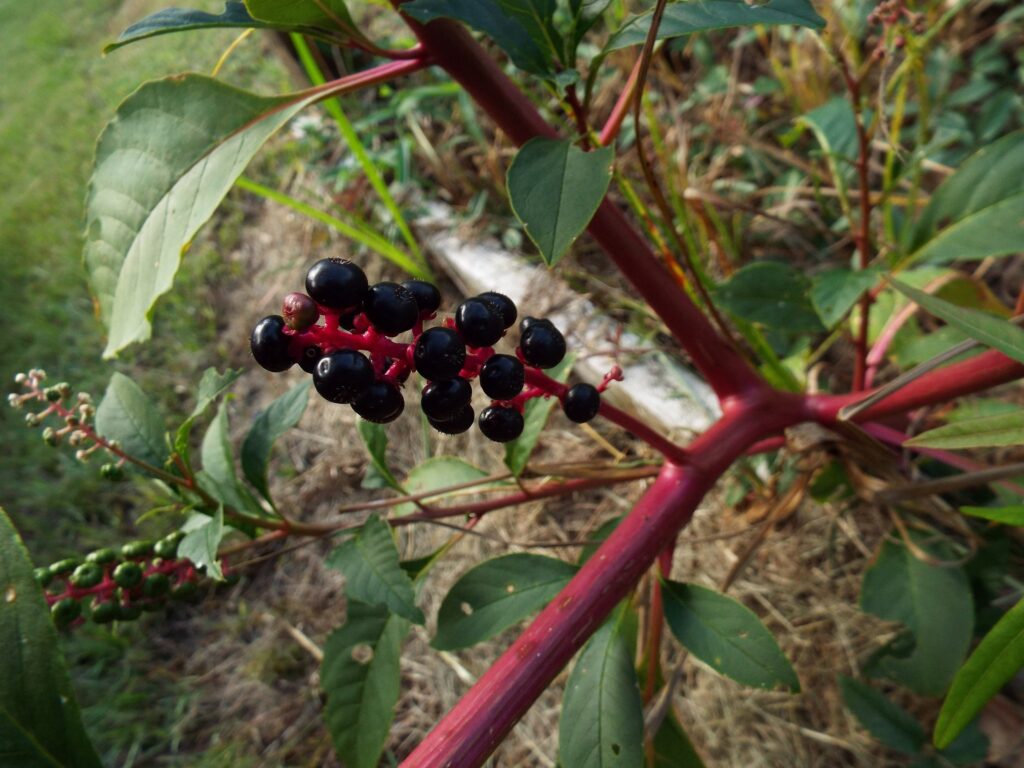
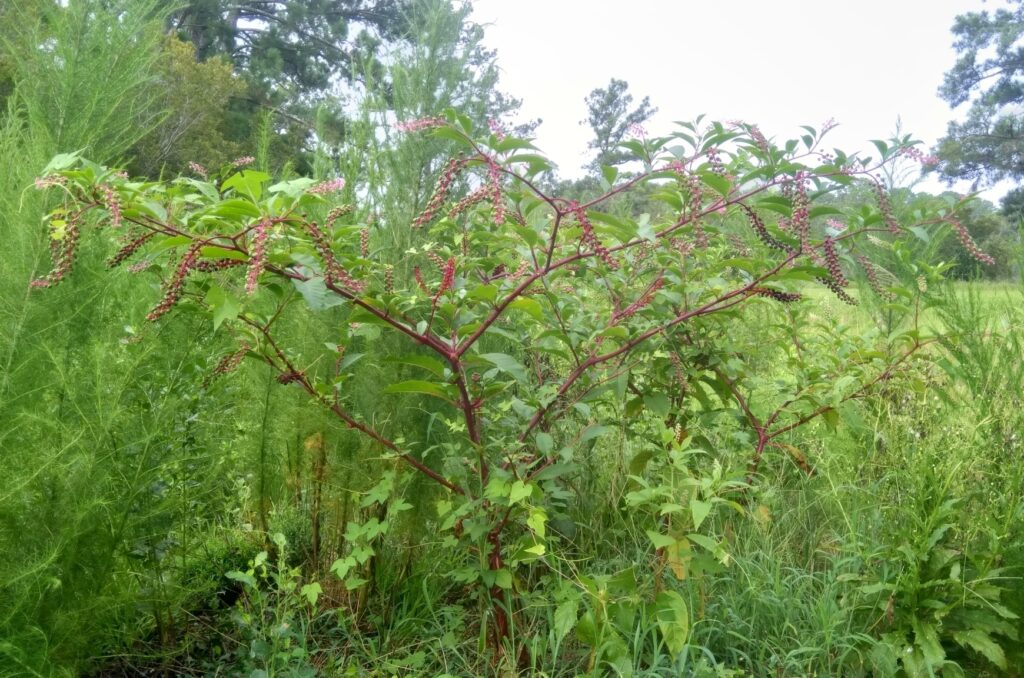
This week for Flora and Fauna Friday we have a pink and prolific poisonous weed found throughout our state, Pokeweed (Phytolacca americana).
Pokeweed is a robust herbaceous plant found in a wide range of habitats across the eastern United States. It’s most often encountered in sunny areas on the outskirts of forests and along field edges. The plant reaches four to five feet in height and nearly the same in width but can get far larger if growing conditions are right. Pokeweed’s stems are thick, smooth, and dyed a deep fuchsia across the whole of the plant. The leaves are large, elliptical shaped, and often drooping. Pokeweed blooms throughout summer and fall, producing piles of flower spikes wrapped in tiny, five-petalled creamy-pink flowers. The old flowers set fruit as the new flowers emerge until the spike reaches about four to eight inches long. The berries ripen from an olive green to a deep, inky black that attracts fruit eating birds. Songbird species like Mockingbirds, Cardinals, Catbirds, and Thrushes dine on the berries and spread the seeds during their daily lives.
All parts of the Pokeweed plant are poisonous to mammals, especially the roots, but birds are immune to the poison. However, young Pokeweed leaves and shoots are often eaten by folks in the Southeast in a dish called Poke Salad. New growth is harvested and then boiled and washed in fresh water several times to denature and draw out the toxic chemicals. Then the cooked greens are served like Spinach. The berries can also be used to create a pink dye, which does retain its toxic quality.
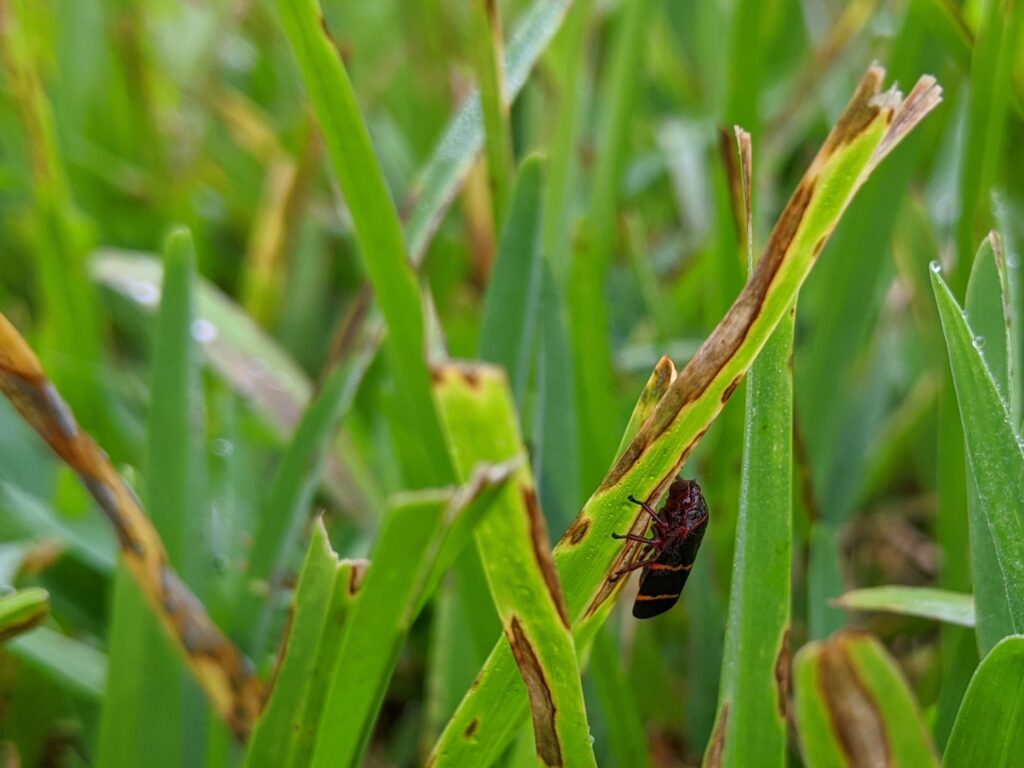

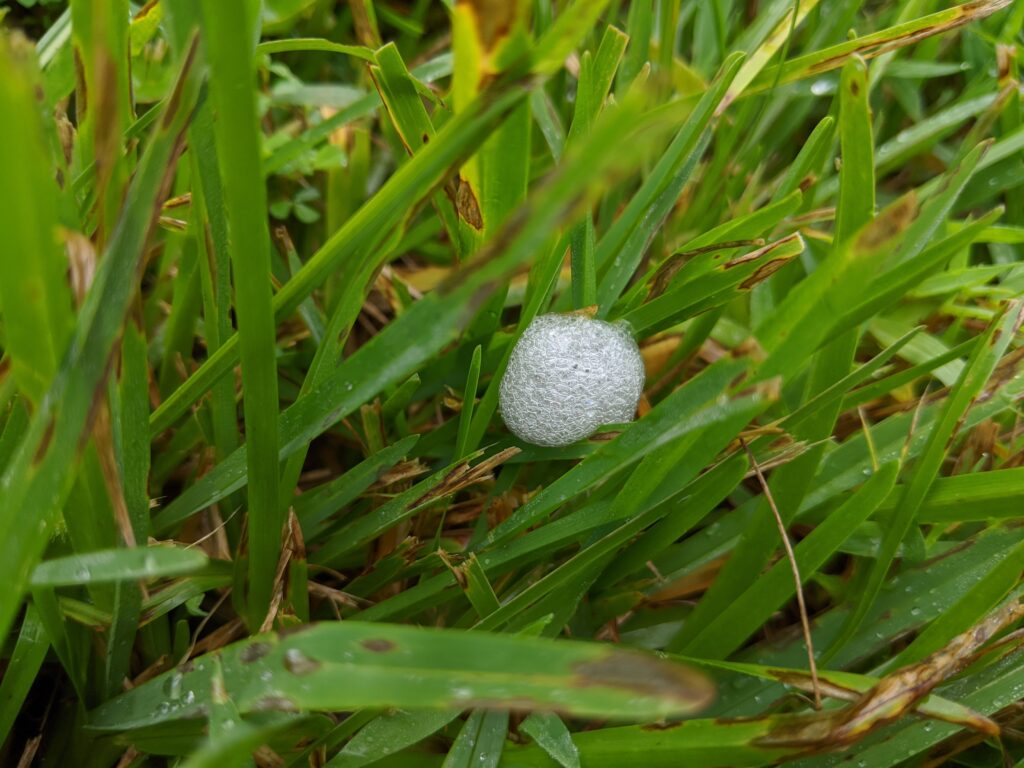
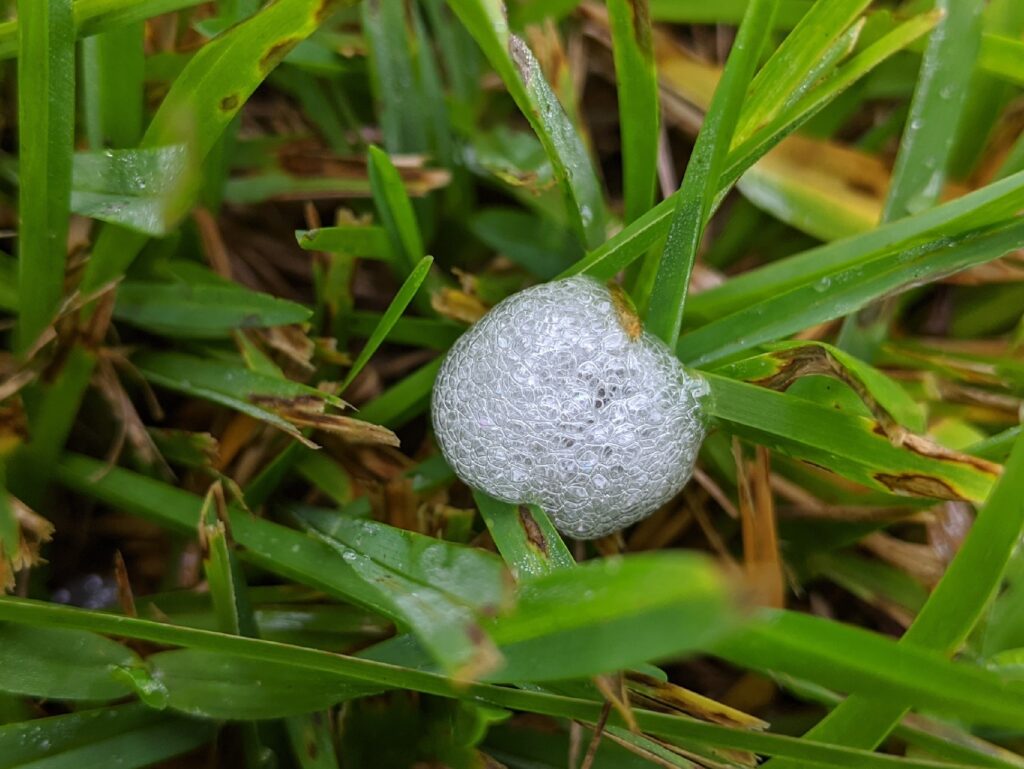
This week for Flora and Fauna Friday, ubiquitous and unmistakable we have an energetic little insect: the Two-lined Spittlebug (Prosapia bicincta).
The Two-lined Spittlebug is what’s referred to as a true bug, a member of the order Hemiptera. This clade is the only clade of insects that can be accurately and technically refer to as “bugs”. The Two-lined Spittlebug is a member of the Spittlebug superfamily Cercopoidea, of which there are a dozen or so species within South Carolina. Yet, the Two-lined Spittlebug is by far the most easy to recognize Spittlebug and arguably the most common in suburban environments. It wears a set of oily-black wings, evenly divided by a pair of tangerine bars, above a head, belly, and thorax dipped in a lustrous garnet-red. When poked at, they will leap explosively into the air on powerful legs to take to the sky on sluggish wings.
Two-lined Spittlebugs, like Cicadas and Leafhoppers, make their living drinking plant fluids. Today’s bug prefers turf grass juice as a snot-nosed nymph and Holly liqueur as a refined adult. This gives them a solid niche in suburbia as turf grass is pre-requisite to a yard and nearly every one of those yards has some shape of Holly, be it a feral Yaupon, hedged Chinese Holly, or shade tree American Holly.
What gives Spittlebugs their common name is the way their nymphs feed. Spittlebugs lay their eggs on their preferred larval host. Upon hatching, the nymph latches on and begins to suckle from the vasculature of that plant. However, unlike most insects, Spittlebugs feed from the xylem of the plant rather than the sap filled phloem. The xylem is the layer that carries water and mineral nutrients to the leaves, rather than sugary sap to the roots, its sap is less nutritious. Spittlebugs actually have specialized gut microbes that produce the essential amino acids the xylem lacks. As a result of xylem feeding, the baby Spittlebugs ingest and excrete excessive amounts of water. That water is then frothed up by the bug into a protective ball of foam, which resembles saliva. The foam shields it from predators, sunlight, temperature swings, and the drying air. Throughout spring, the nymphs molt and grow until the adults emerge in summer. These adults lay their eggs and a second brood comes forth in fall.